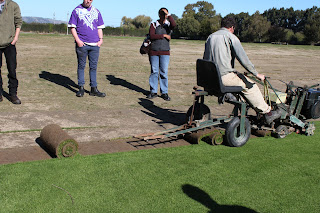On 26/04/2013 after my Machinery Unit with Kim Thomas on how to operate four stroke lawn mover and two stroke lawn mover. In the afternoon behind the backyard there some old rose plants which is quite sick because of powdery mildew and black leaf spot. Then I decided to cut the hardwood cutting on the stems.
The two photos are the pink roses which now is attacked by powdery mildew and black leaf spot and left by no leaves on the plants.
After most of leaves have dropped and woody plants will go dormant and this is the time to do hardwood cuttings. For many woody plants this s the easiest way to ensure propagation, partly because they are so impervious to damage at this stage and partly because the callus that forms on the end of the stem over winter stimulates root production.
There are three types of hardwood cuttings such as straight, mallet and heel cuttings. Straight hardwood cutting just cut below a node of the past season's growth. Make the bottom cut straight across the wood and the top cut slanted. Mallet cutting one that includes 1/2 or 1 inch of the branch from which the stem grows when you take the cutting. Heel cutting a sliver of the bark and some of the interior of the wood from which the cutting emerges and most suitable for conifers.
- Cut ideally, hardwood cuttings should be about as thick as a pencil and remove any softwood at the top. Make the bottom cutting straight across and top cut at a slant.
- Cutting usually between 5 - 15cm long.
- Dibber holes in your planting media and place the cutting into the holes. Firm the medium around the cuttings and water well.



































































